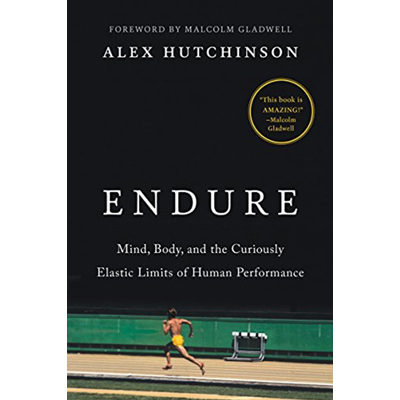 Title: Endure – Mind, Body, and the Curiously Elastic Limits of Human Performance
Title: Endure – Mind, Body, and the Curiously Elastic Limits of Human Performance
Author: Alex Hutchinson, PhD
Year: 2018, William Morrow
Pages: 306
If you are as fascinated with endurance as I am, then you will love this book.
I can hear some of you saying, “I’m never going to run a marathon! What the heck do I care?”
Well, whether you are walking to the mailbox or raising kids or working three jobs 16 hours a day, how to endure is really an important question.
Have you ever really stopped to think about how much faster a human can run a mile or hold his breath or tolerate cold or, in a pinch, lift a car off a person?
What are the limits of a human and what makes them go farther and longer and deeper and faster?
This book uncovers so many critical questions, which are mostly, yes mostly, answered. Questions like what is the role of pain and the perception of pain? And what is the difference between dehydration and heat stroke? What are the limits of human endurance? As with all great questions, more questions are generated! Such is the life of science. So, consider this an up to date, though never complete, explanation of human endurance. I’m sure more controversy will follow. And more questions.
3 SENTENCE SUMMARY
- The distinction between physical and psychological endurance is actually less clear-cut than it appears. (9)
- The psychology and physiology of endurance are inextricably linked: any task lasting longer than a dozen or so seconds requires decisions, whether conscious or unconscious, on how hard to push and when. (11)
- Brain and body are fundamentally intertwined. (15)
THE REVIEW
Any book having a forward by Malcolm Gladwell is automatically moved to the front of the line. (If you are unfamiliar with Mr. Gladwell, start with his book BLINK, we have two copies in the office). And any book having the late Steve Prefontaine, arguably the greatest American distance runner of all time, in full stride on the cover, is doubly going to the front of my list. And if you couple these two things with a narrative about human endurance, well… I’m all in.
First off, Hutchinson is a first-class reporter. He doesn’t settle for easy answers and chases down experts with the tenacity of a Pitbull. He does all this without getting in the way of the narrative, even when he is sharing from his own experience as a distance runner. This is no small feat. He is also a scientist, he has a PhD in physics, he is able to analyze data and give it perspective. Plus, he has “street cred.”
So, what type of perspective?
Hutchison takes the two current competing theories of human endurance and dissects them both with the skill of a surgeon. He does it so well that I found myself agreeing with both arguments! But as usual the truth lies partly between both theories and partly with neither.
One perspective expounds “mind over matter.” The other “matter over mind”. Believe it or not, this is a pretty contentious debate in athletic circles.
So, which is it?
The answer is…. Both! Sort of!
Particularly engaging about this book is the way it is laid out. If you know or care anything about the running event known as the marathon, 26.2 miles, you know that it is a ridiculous feat of human endurance. For the past several years, Nike has been hard at work trying to break the 2-hour barrier in the event. Like the 4-minute mile broken in the ‘50’s, this barrier has been thought to be unbreakable. A human simply could not run that fast that long. Interspersed throughout the book are short updates about this saga culminating in an historic effort. These sections alone are worth the read.
Hope you enjoy!
Cheers,
KS
For those who read quickly, the book is available for checkout in our office. For those wanting to take their time we recommend you purchase through your favorite book source.
